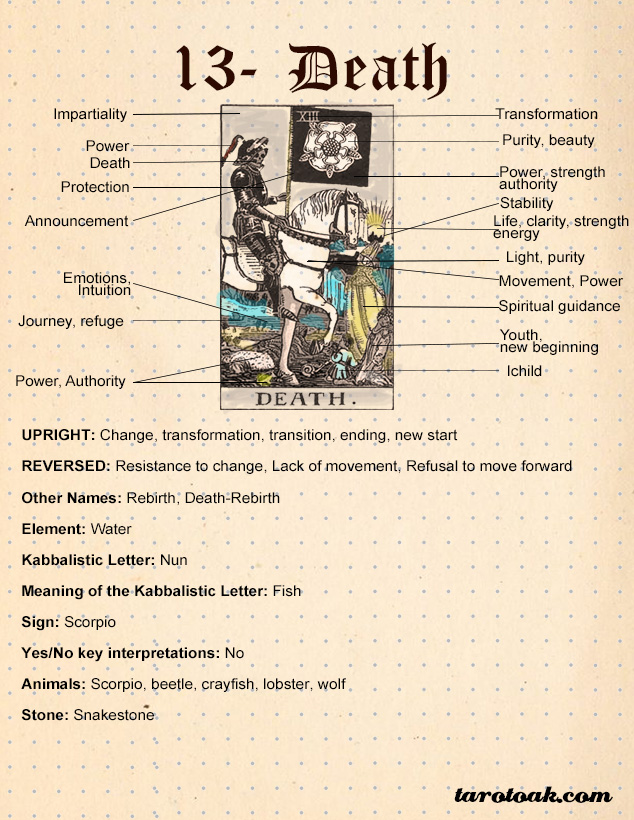The Death card in the Tarot, often cloaked in an aura of foreboding, evokes more than mere dread. In many interpretations, particularly from a Christian perspective, it serves as a herald of transformation rather than an omen of demise. This card embodies the philosophical notion that every ending is a prelude to a new beginning. The intricate interplay between life, death, and rebirth finds profound resonance within the Christian faith, offering believers a lens through which to understand the mysteries of existence.
Central to the Christian worldview is the concept of resurrection and eternal life, themes that harmonize intriguingly with the symbolic meaning of the Death card. In Christianity, death is not final; it is a transitory phase that leads to rebirth. The Christian doctrine teaches that with Jesus Christ’s resurrection came the promise of eternal life for believers. This dovetails with the Death card’s representation of endings that pave the way for new opportunities.
When contemplating the imagery of the Death card—a skeletal figure on a white horse—one may initially perceive a grim entity. However, the skeletal figure symbolizes the stripping away of the old to make room for the new. Much like the spiritual journey in Christianity, where believers must sometimes shed their past selves and embrace change, the Death card beckons individuals to relinquish outdated beliefs or habits that no longer serve them. This is mirrored in the Biblical narrative of spiritual renewal and transformation.
The importance of embracing change cannot be overstated. Christians are often encouraged to view life through the lens of hope and renewal, as echoed in Romans 12:2, which advises believers to “not conform to the pattern of this world, but be transformed by the renewing of your mind.” Here, the Death card acts as a reminder that metamorphosis is not only desirable but divinely orchestrated. It is a call to cast off the past and step boldly into a future filled with the promise of spiritual progress.
Furthermore, the narrative of loss and resurrection plays a pivotal role in the understanding of the Death card. In Christianity, Christ’s crucifixion is a poignant symbol of ultimate sacrifice—a death that brings about salvation and hope. The Death card, in this light, resonates with the principles of sacrifice and redemption, inviting individuals to reflect on what they might need to let go of in order to make room for healing and rejuvenation in their lives.
1. Recognizing Personal Transformation
As the Death card appears in a reading, it beckons one to contemplate personal transformations. It prompts reflection on the elements in life that have reached their culmination, urging one to articulate what must be released. This process can be inherently cathartic, much like the Christian practice of confession which seeks to cleanse the soul of burdensome guilt and regret, allowing for spiritual renewal.
2. Embracing the Impermanence of Life
In Christian theology, the transient nature of life is highlighted throughout the Scriptures, serving as an admonition against earthly attachments. The Book of Ecclesiastes poignantly articulates that “for everything, there is a season.” The Death card intricately weaves this notion, symbolizing the cycle of life—a reminder to cherish the present while recognizing that change is an inevitable aspect of existence.
3. Fostering Resilience
Confronting the implications of the Death card can cultivate resilience. In Christianity, believers are taught to find strength in adversity. The card urges the individual to find courage in the face of inevitable changes, resonating with Philippians 4:13, which states, “I can do all things through Christ who strengthens me.” This empowering perspective allows one to approach transitions not with apprehension but with a sense of purpose and strength.
4. The Power of Letting Go
Letting go can be one of the most arduous battles to face, yet it is essential for growth. The Death card encourages individuals to assess their attachments—be it to people, places, or outdated beliefs—and urges a willingness to release. Similarly, Christians are called to surrender their burdens at the foot of the cross, embodying the fundamental tenet of faith that one must relinquish control to achieve spiritual growth.
5. Embracing Hope and New Beginnings
Ultimately, the Death card, when viewed through the lens of the Christian faith, breathes hope. It signifies that from every ending springs the potential for a renewed existence. Just as Christ’s resurrection after death symbolizes the fulfillment of divine promises, so too does the Death card promise the emergence of new opportunities. This message is profoundly hopeful, encouraging believers to trust in God’s plan for their lives, even amidst turmoil.
In conclusion, the Death card in Tarot serves as a catalyst for profound reflection within a Christian framework. It reiterates that every ending is a chance for renewal, encouraging individuals to embrace their spiritual journeys with faith and anticipation. By shifting perspectives and recognizing the transformative nature of transitions, one can cultivate a deeper understanding of life’s cyclical nature. Thus, the Death card becomes not merely a symbol of mortality but a vibrant emblem of hope, inviting curiosity and introspection into the ever-evolving tapestry of existence.









Leave a Comment